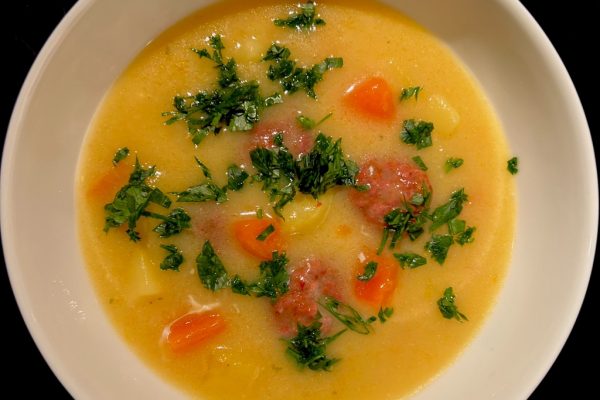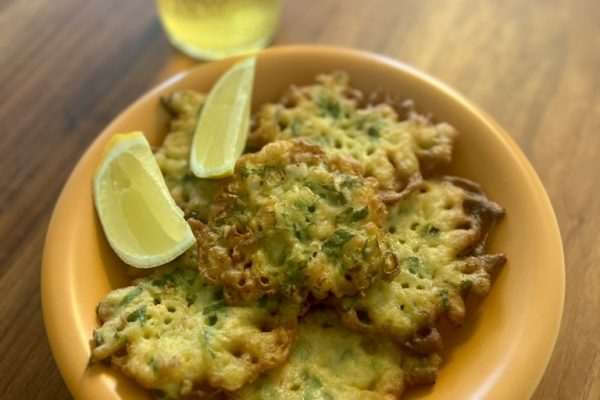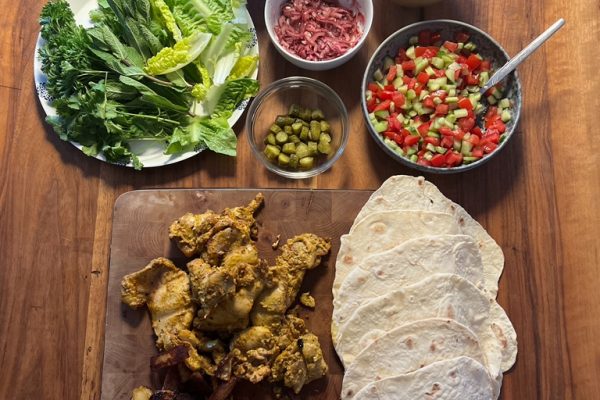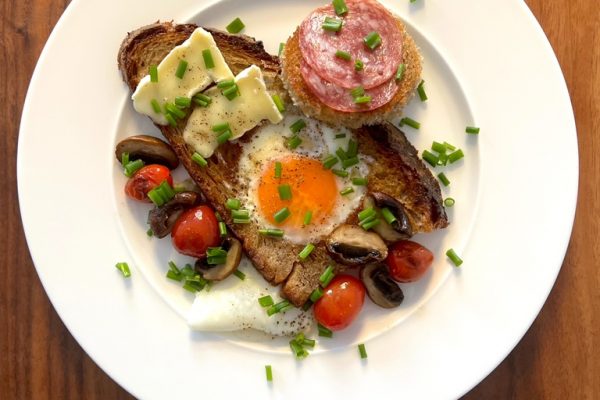Khadi pakora is a traditional North Indian dish that boasts an enormous variety of flavours. The preparation is less complex than it may seem, so don’t be put off by the seemingly long list of ingredients.
This speciality combines crispy pakora (deep-fried vegetable balls) with a creamy sauce made from sour cream or sometimes yoghurt. You will hardly find it on restaurant menus.
Khadi pakora can be served in different ways. Some prefer it as a main course with rice or fresh bread, while others enjoy it in combination with other Indian dishes.
We start with coriander seeds, which we roughly crush in a mortar. Make sure that you use enough to put some in the sauce and some in the pakora. Don’t skip this step, you won’t get the typical flavour with coriander powder.
For the sauce base, we also need sour cream, ginger and garlic paste (or finely grated ginger and garlic), turmeric, Kashmiri chilli powder, a little salt and a little gram flour.
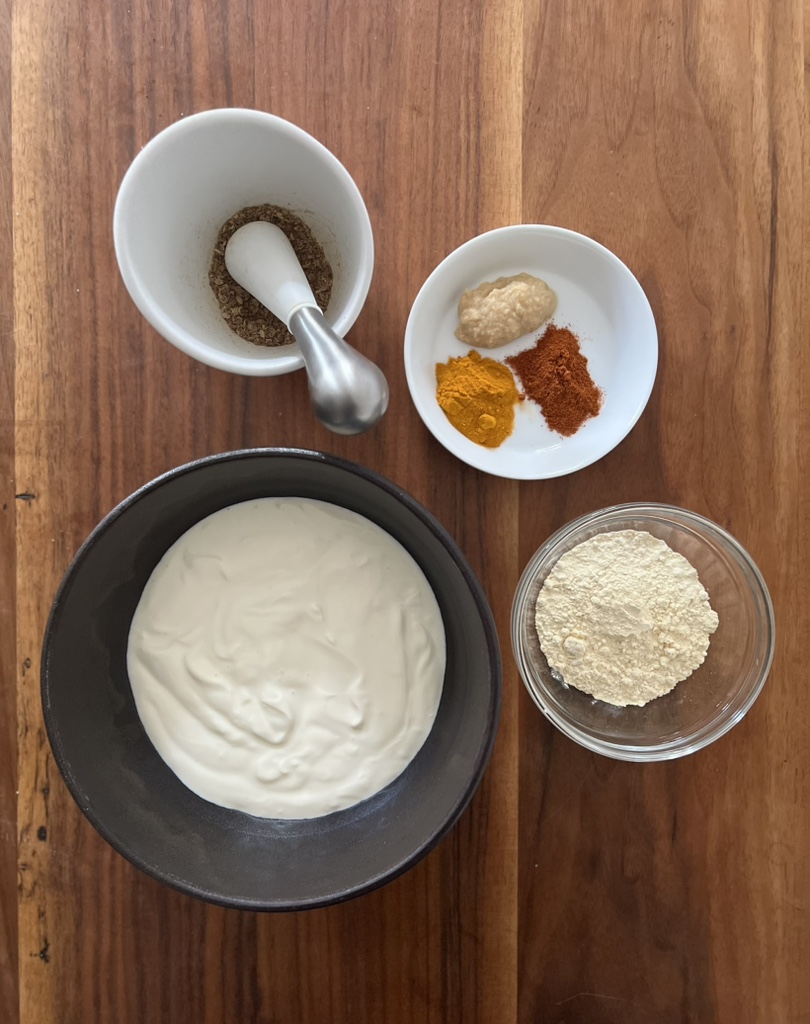
Finely sieve the flour into the sour cream so that no lumps form. Then use a whisk to combine all the ingredients into a smooth mixture.
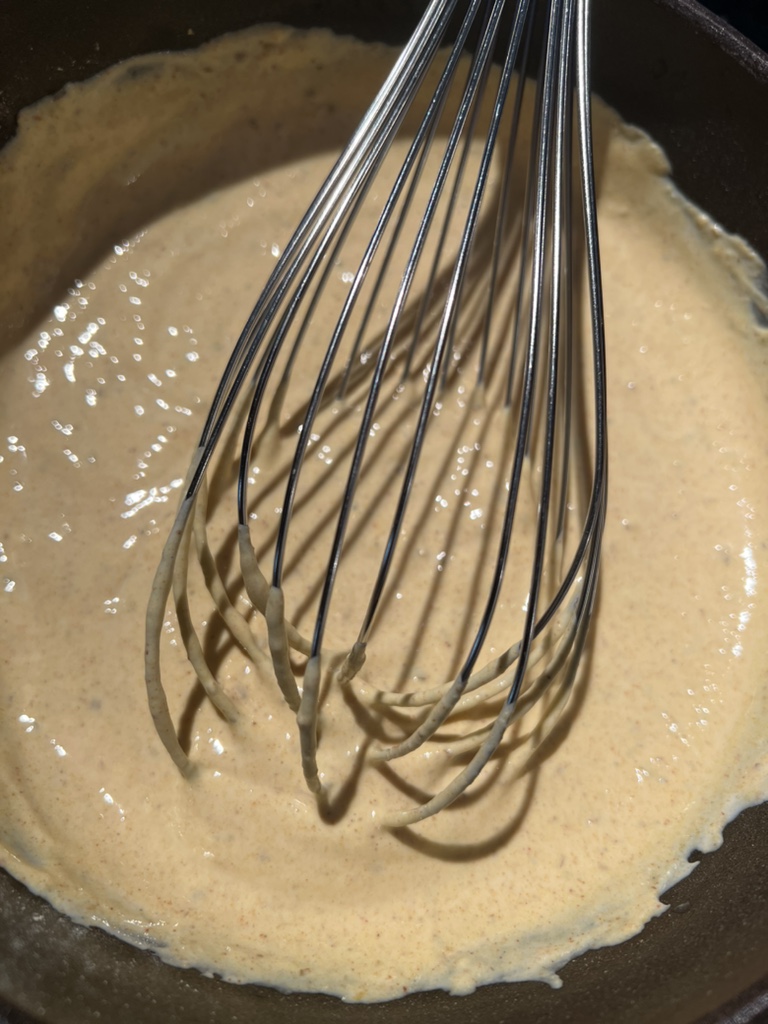
Heat a little ghee, which is clarified butter, in a large pot. Add cumin seeds and a little ground fenugreek seeds. Fenugreek is very hard and can be ground either in a mortar or in a spice grinder. We roast these spices for 30 seconds and they immediately give off a wonderful aroma that is typical of Indian cuisine.

Add chopped onion, a little salt and a pinch of asafoetida (called hing in northern India). Fry the onions over a medium-high heat until translucent and lightly browned. If you want a spicier dish, add one or two dried red chillies at this point and let them cook with the sauce.

Then we add our prepared sauce base and water and mix everything together again with a whisk.

This mixture must now simmer gently over a medium heat for at least 40 minutes with the lid on so that the chickpea flour swells and is cooked out. The mixture should not boil vigorously, however, so that the sour cream does not separate and forms a fine bond with the flour and, of course, the spices. Stirring occasionally prevents the flour from burning at the bottom of the pot.
After 40 to 50 minutes, the sauce is ready and can be seasoned with salt to taste. Ground black pepper also goes very well with it. Finish with chopped coriander leaves.

While the sauce is simmering, you have enough time to prepare the pakora. To do this, we halve medium-sized onions and cut them lengthways along the fibres into thin strips. We also halve a fresh green chilli so that we can remove the seeds. Then we chop the chilli as finely as possible. We season with cumin seeds, Kashmiri chilli, turmeric, more crushed coriander seeds and fresh coriander, the stems of which can also be chopped and used. We also add half a teaspoon of salt.

We add gram flour on top and then knead everything vigorously with our hands for a few minutes so that the liquid from the onions combines with the flour. This is a sticky affair, don’t worry, that’s how it has to be.

Now we carefully add a small amount of water, just a few tablespoons, and continue kneading until the flour has become a smooth, strong paste that holds the onions together. How much water you need depends very much on the onions. You must not use too much, as the mixture needs to remain sticky so that the pakora can hold their shape.

We then heat frying oil or vegetable fat over a medium-high heat until bubbles form on a submerged wooden spoon. The desired temperature is approx. 170 degrees Celsius. We like to use a wok for this because its shape means less oil or fat is needed. We also like to use vegetable fat in solid form, as it can be poured through a sieve after frying, allowed to harden again and stored in the fridge for further use.
Now we take half a tablespoon of our onion mixture at a time and spread it into the hot oil with a second tablespoon. The little balls that form now need about 4 – 5 minutes to turn golden brown. If this happens more quickly, the oil is too hot and the dough in the centre may not fully cook. If this should happen, take the oil off the heat briefly to cool it down. Use the tablespoons to turn the balls once halfway through so that the top and bottom are cooked equally.

Place the finished pakora in a colander to drain, placing it on a plate to catch any excess oil.

Once all the balls are prepared and the sauce is cooked, we heat the oil again on a high heat and deep-fry the pakora a second time for just 15 seconds so that they are crispy and hot. The second frying also means that less oil sticks to the pakora, which we put back into the colander until serving.
Then we plate our dish, today with some basmati rice.

This can be further refined by heating a tablespoon of ghee and stirring it with a teaspoon each of cumin seeds and Kashmiri chilli for about 30 seconds until it starts to smell intensely fragrant. This spiced oil is then drizzled over the finished dish.

The leftover pakora were cut in half and enjoyed cold with a little sweet chilli sauce. This is also a great treat.

Enjoy.
And may the taste be with you.
Ingredients (for 4 people):
For the Khadi:
400 g sour cream
30 g gram flour (sieved)
3 tsp coriander seeds (crushed)
1 tsp ginger and garlic paste
1 tsp turmeric
1 tsp Kashmiri chilli
Salt
1 tbsp ghee
1 tsp cumin seeds
Some coarsely ground fenugreek seeds
A pinch of asafoetida
Optional: dried chilli
1 onion
1,100 ml water
Fresh coriander
For the Pakora:
3 medium onions
1 fresh green chilli
1 tsp cumin seeds
1 tsp Kashmiri chilli
½ tsp turmeric
2 tsp coriander seeds (crushed)
Fresh coriander
Salt
140 g gram flour
Water
Fat or oil for frying

